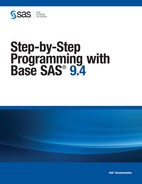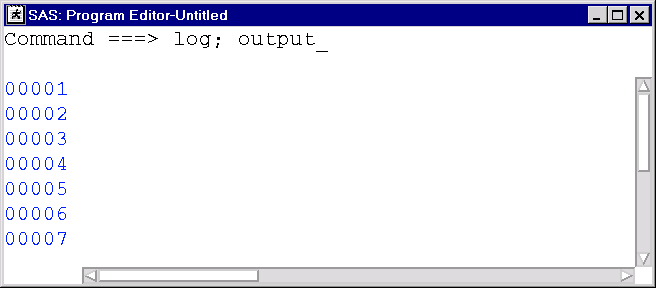Using SAS Windowing Environment Command Types
Overview of SAS Windowing Environment Command Types
There
are specific types of SAS windowing environment commands. The type
of commands that you use might depend on the task that you need to
complete, or on your personal preferences. These commands can be
in the form of:
For information about
specific commands that can be issued in the SAS windowing environment,
see Working with SAS Windows. For information about
specific commands that can be used in the SAS text editor, see Working with Text.
Using Command-Line Commands
If the command line
is turned on, then you can place your cursor on the command line and
type commands. You can toggle the command line on or off for a specific
window by selecting Tools Options
Options Turn Command Line On or Tools
Turn Command Line On or Tools Options
Options Turn Command Line Off.
Turn Command Line Off.
The Command window
(if it is available in your operating environment) includes a text
area. You can place your cursor in this area and then issue commands.
To execute a command,
type the command on the command line and then press the ENTER key,
depending on which operating environment you are using. You can specify
a simple one-word command, multiple commands separated by semicolons,
or a command followed by an option.
For example, if you
want to move from the Editor window and open
both the Log and the Output windows, on the command line of the Editor window,
specify
log; output
Using Menus
SAS windowing environment windows can
display menus instead of a command line. You can then make menu selections
to do things that you would usually accomplish by entering commands.
If your operating environment
does not default to using drop-down menus, then issue the PMENU command
at a command line to turn on menus for all windows that support them.
You can point and click
menus and menu items with a mouse to make your selections. In some
operating environments, you can also make menu selections by moving
your cursor over the menu items and then pressing ENTER or RETURN.
Depending on the item that you select, one of three things happens:
In many cases, double-clicking on items and right-clicking
on items will cause different menus to appear. Sometimes you might
want to try one or the other when selecting an item does not give
you the expected result.
Using Line Commands
Line commands are one
or more letters that copy, move, delete, and otherwise edit text.
You can execute line commands by entering them in the numbered part
of a text editing window (such as the Editor or the SAS NOTEPAD).
Although line commands
are usually executed in the numbered part of the display or with function
keys, they can also be executed from the command line if preceded
by a colon.
For more information
about line commands, see Working with Text.
Using Function Keys
Your keyboard
includes function keys to which default values have already been assigned.
You can browse or alter those values in the Keys window.
To open the Keys window, select Tools Options
Options Keys or issue the KEYS command.
Keys or issue the KEYS command.
To change the setting
of a key in the Keys window, type the new
value over the old value. The new setting takes effect immediately
and is saved permanently when you execute the END command to close
the Keys window.
Function keys enable
you to customize your key settings to meet your needs in a particular
SAS session. For example, if you might need to submit a number of
programs and need to move between the Editor window
and the Output window. Then each time you
finish viewing your output, you must type the PGM and ZOOM commands
on the command line and press ENTER or RETURN. As a shortcut, define
one of your function keys to perform this action by typing the following
commands over an unwanted value or where no value existed before:
..................Content has been hidden....................
You can't read the all page of ebook, please click here login for view all page.

